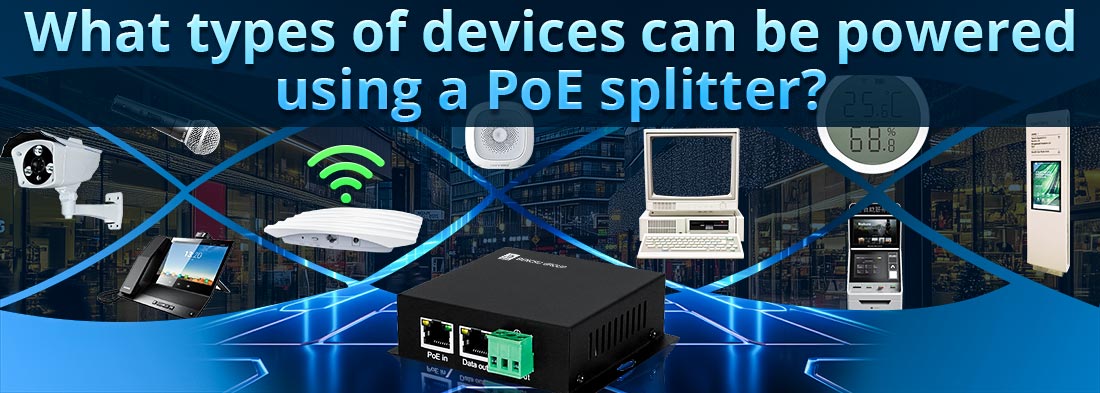
Um divisor de POE é útil para alimentar dispositivos não-POE que requerem entradas de potência e dados separados, mas estão conectados a uma rede habilitada para POE. Ele extrai a energia do cabo Ethernet e o converte em uma tensão utilizável (por exemplo, 5V, 9V, 12V ou 24V DC) enquanto passa pelo sinal de dados para o dispositivo.
Tipos de dispositivos que podem ser alimentados usando um divisor Poe
1. Câmeras IP (não-POE)
--- Muitas câmeras IP, especialmente modelos mais antigas, não suportam POE nativamente, mas exigem conexões de energia e dados.
--- a Poe Splitter Permite que essas câmeras sejam usadas em redes POE sem exigir adaptadores de energia adicionais.
2. Pontos de acesso sem fio (WAPS)
--- Alguns pontos de acesso sem fio (WAPS) não suportam o POE diretamente, mas ainda precisam de energia e dados.
--- Um divisor POE converte a entrada POE em uma tensão CC compatível para o WAP, garantindo que a conexão de dados permaneça intacta.
3.
--- Muitos telefones de VoIP modernos são compatíveis com POE, mas alguns modelos mais antigos ou orçamentários podem exigir uma fonte de energia separada.
--- Um divisor de POE permite que esses telefones sejam alimentados via Ethernet sem precisar de um adaptador CA.
4. Raspberry Pi e pequenos computadores de placa única
--- O Raspberry Pi e outros computadores de placa única (SBCs) geralmente requerem entrada de 5V DC.
--- O uso de um divisor POE com uma saída de 5V permite que eles sejam alimentados diretamente de uma rede POE sem tijolos de energia adicionais.
5. Conversores de mídia de rede
--- Conversores de mídia (usados para converter fibra-óptica em Ethernet) geralmente requerem energia CC.
--- Um divisor POE fornece a energia necessária, garantindo a transmissão de dados ininterrupta.
6. Sistemas incorporados e dispositivos IoT
--- Vários dispositivos, sensores e controladores da IoT (Internet das Coisas) precisam de potência de baixa tensão e conectividade Ethernet.
--- Um divisor de POE ajuda a implantar esses dispositivos em áreas onde as tomadas de energia não estão prontamente disponíveis.
7 Mini PCs e thin clients
--- Alguns PCs leves, como mini PCs sem ventilador ou thin clients, exigem uma entrada CC de baixa tensão.
--- Um divisor de POE pode fornecer acesso e acesso à rede simultaneamente.
8. Displays e quiosques de sinalização digital
--- Algumas telas menores de LCD ou quiosques interativos dependem do Ethernet para obter dados e requerem uma fonte de energia CC separada.
--- Um divisor de POE pode ajudar a simplificar a instalação, reduzindo a desordem do cabo.
9. Hubs e controladores de casa inteligentes
--- Controladores de automação residencial como hubs inteligentes (por exemplo, ZigBee, Z-Wave Controllers) geralmente precisam de uma fonte de energia estável.
--- a Poe Splitter Pode ajudar a alimentar esses dispositivos, mantendo uma conexão Ethernet confiável.
Considerações importantes ao usar um divisor de Poe
1. Compatibilidade de tensão - Verifique se a tensão de saída do divisor POE corresponde aos requisitos de energia do seu dispositivo (por exemplo, 5V, 9V, 12V ou 24V).
2. Requisitos de energia - Verifique se o divisor fornece potência suficiente para o dispositivo.
3. PARTEM POE - Combine o divisor com o padrão POE correto (802.3AF para dispositivos de menor potência, 802.3AT para obter mais necessidades de energia).
4. Tipo de conector - Verifique se o plugue de saída CC do divisor é compatível com a entrada de energia do seu dispositivo.
Conclusão
Um divisor de POE é uma solução econômica para implantar dispositivos não-POE em uma rede movida a POE. Ele elimina a necessidade de adaptadores de energia separados e facilita a instalação de dispositivos em locais sem tomadas de energia próximas. Ao escolher a tensão correta e o padrão POE, você pode alimentar eficientemente câmeras IP, pontos de acesso, telefones VoIP, placas de Raspberry Pi, sinalização digital e muito mais.